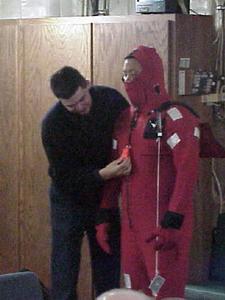17 July, 2002
We are waiting to arrive at our second station in the
Bering Strait. We should reach there in about 15
minutes. There will be three more stations before we
call it a night. It's 9:15 PM already.
I will add more information and pictures from the last
few days tomorrow when I finally get my computer set
up and connected. The one coast guard crewman
responsible for all such questions and problems is a
busy man!
Here is my actual journal for the 17th.
Today was a long and busy day. The ship finally got
underway around 8:30 in the morning. Soon after, we
all gathered in the science conference room for an
introductory talk about safety and about the ship in
general. After we all introduced ourselves, we met
several of the crew who explained everything from
water conservation, laundry, and trash to the all
important rules for emergencies on board. After
lunch, we held an abandoned ship drill where we all
moved to our assigned muster station (designated place
to gather) and heard what to do if the abandon ship
alarm sounds. If this happens, everyone goes to a
muster station where they put on a special survival
suit (you can see someone trying it on in the picture
below) to wear before entering the water or your life
raft. A life preserver is useless in water this cold!
We learned that, before you put on the suit you
should always write down the latitude, longitude,
water temperature and other announced information on
the back of your hand and drink plenty of water
because no water is issued for the first 24 hours in
the lifeboat.
After lunch, everyone made final preparations for our
first station. Initially I thought I would be on the
traditional schedule of 12 hours on and 12 hours off
throughout the cruise. While a few on board follow
that schedule, most simply try to catch up on sleep
and other work in between stations because a station
may last several hours, and we can arrive at a station
at any time of the day or night. We reached the first
of five stations in the Bering Strait around 9:15 PM.
Because the bottom is rocky, we did not do any bottom
sampling. The actual sampling at all five of
tonight’s stations was a “service cast.” This is when
the service team goes into action. This team of
scientists coordinates deployment of the equipment
needed to gather water samples from various depths.
They also carefully coordinate who gathers water and
when once the bottles reach the surface. In the
pictures below you can see the Niskin bottles used to
gather water. As the rosette (ring of 12 bottles) is
lowered into the water, each is triggered by computer
to close and gather water at a certain depth. CTDs
are computer controlled devices under the Niskin
bottles. They collect information on conductivity,
temperature and pressure (used to calculate depth) as
the rosette descends into the water.
Once the rosette reaches the surface and is brought on
board, there is a strict order for collecting samples.
After the service team collects their information
(ex. salinity and oxygen), each science team collects
the water they need for their work. I worked with Jim
Bartlett, a technician working with Dr. Lee Cooper, to
collect sample for oxygen-18 analysis. We preserved
the samples so they can be brought back to the
University of Tennessee for analysis.
The station that started at 9:15 eventually ended
around 4:30 AM. You can see why the scientists grab
sleep any chance they get!

Carny Cheng, as member of the service team, volunteered to try on the survival suit, nicknamed the "Gumby suit." A member of the crew, ENS Joseph Castaneda had to help him get into it!

It's easy to see the size of the Niskin bottles in this picture. Lots of people need to draw water from them.

I collected very small bottles of water for oxygen-18 sampling. Ari Balsom is collecting large volumes of water that she will filter for POM (parcticulate organic matter). She's looking for small organims in the water.
Contact the TEA in the field at
.
If you cannot connect through your browser, copy the
TEA's e-mail address in the "To:" line of
your favorite e-mail package.
|
